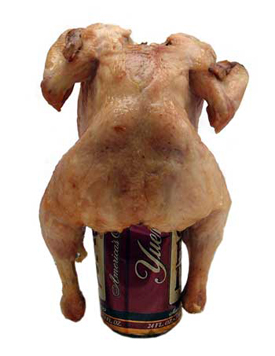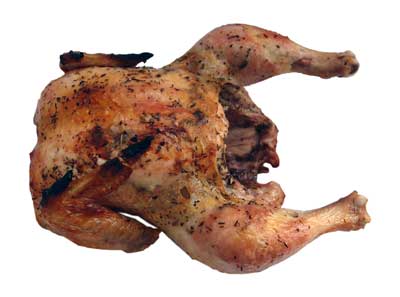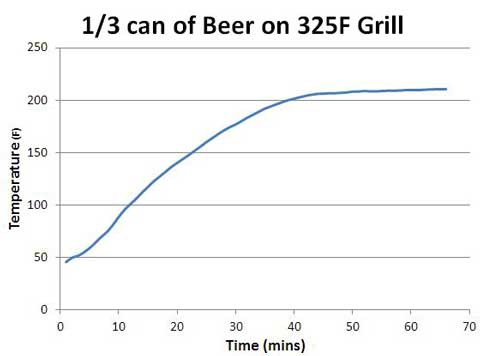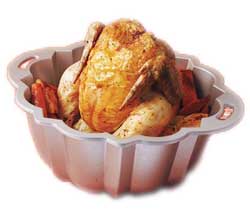| g e n u i n e i d e a s | ||||||
 |
 |
 |
 |
 |
 |
 |
| home | art and science |
writings | biography | food | inventions | search |
| kick the can |
|
June 2012 Grilling. The allure of combining all three vices into one ultimate roast chicken recipe, is irresistible. Thus we are graced with “beer can chicken”. Instead of baking a whole chicken- resting gently in the oven as if sleeping on a bed- in beer can chicken you stick a can up the chicken’s rear end, and roast it standing at attention. Aficionados maintain beer steams the chicken from the inside (contributing flavor and moistness), while roasting the skin to crispy perfection. But does this recipe deliver as promised? To find out, we compared a horizontally roasted chicken to a beer-can chicken to a vertically roasted chicken impaled on a wire frame. Both on the grill and in the oven. For the sake of kitchen science, our preparation is a simplified version of a reliable roast chicken recipe1. A half hour before cooking, a 3-4 lb chicken is rubbed with salt (for flavor and to retain moisture) mixed with a bit of baking soda (to promote browning). We removed any excess skin around the base of the cavity (including the “pope’s nose") along with the neck bone, so there was a clear path through the cavity for air to flow. All tests were performed at 325F, and the birds were cooked until the breast meat reached 165F (and the thighs 185F). About an hour for a three pound bird, and 80 minutes for a four pounder And here are the results from a typical kitchen convection oven:
Note how the chest cavity air temperature of this 3 lb free-range bird is in sync with the oven (which cycles on and off via a thermostat). This indicates oven air is flowing through the cavity. But, it took an entire hour for the air cavity temperature to just barely reach the steam level of 212F. Until then, moisture in the cavity evaporatively cooled the passing 325F oven air well below boiling. Demonstrating there is plenty of humidity in the chest cavity without a beer can. Despite the low temperature inside the bird, the chicken is lightly brown and very moist and tender.
Once again, we placed thermocouples inside the middle of the cavity and the middle of the breast (we also checked to be sure the legs were done using a portable stick thermometer). As with horizontal roasting, the air inside the cavity exhibits small bumps in sync with the oven temp, rising to steaming about the time the bird finished cooking. From repeating this test a number of times, there is no significant difference in the cooking times between a horizontal and a vertically roasted chicken.
And again, the meat was tender. Not surprising given the similar cooking times and ending temperatures.
Thermocouples were inserted in the breast meat, the beer, and above the beer can. With telling results--- Unlike the open cavity, the beer can blocks airflow but is in excellent thermal contact with the meat. So, its not surprising the meat, the beer and the air above the beer can all rise roughly in tandem. Note how oven fluctuations are no longer reflected in the air above the beer can- a result of one side of the cavity being sealed off.
The temperature inside the cavity is LOWER with the beer can than with just plain air (165F vs 212F). And dangerously so, from a bacterial point of view. In fact, this is exactly why the USDA recommends cooking your turkey stuffing OUTSIDE the bird. Inside the cavity, it may never heat up high enough or long enough to avoid food poisoning. Not surprisingly, the weight of the beer can was unchanged. At 165F, not much beer is evaporating. And, the beer and garlic only contributed a slight flavor echo to the meat near the neck, but no where else on the bird.
If we compare the temperatures inside the cavity for all three methods, the beer can method is clearly the outlier: [We also repeated these experiments on the grill with a larger bird. While the extra airflow on a gas grill slightly speeds up the temperature rise inside the cavity, and while a larger bird has a larger neck opening, which facilitates air flow, the differences are quite small4. The little extra heating from the cavity, does however, avoid the chance your thermo will read 160F in the middle of the breast, while the meat near the bone is still pink. A rooky mistake, but a devastating surprise at the dinner table in front of your guests. So a mild cooking advantage on the interior for the wire frame, even if the total cook time is about the same.]Note: Beer can cooking can be dangerous- the can often sticks inside the cavity and when you finally wrench it out, dumps hot water and grease everywhere. A brief thought experiment quickly throws cold water on the entire premise behind beer can chicken. The inside of the bird averages closer to 150F than the exterior's 325F. And, the cavities’ surface area is about 1/10th that of the exterior. With this little heat input, its not going to appreciably speed up cooking. Nor will it add much moisture, since the beer hardly reaches the boiling point, and in any case, most of the cavity is blocked by the beer can’s wall. From a taste perspective, even if a few flavor molecules wafting out of the can entered the meat, it only flavors the top inch or so. Why not rub the bird with herbs and spices under the skin, and do chicken right1? The one thing beer can chicken gets right is vertical roasting. This uniformly cooks the meat, and crisps the skin. As long as you monitor the temperature and catch it when the breast hits 165F, the meat will be moist and tender. So I strongly recommend vertical wire roasting frames, on the grill or in the oven. And keep the beer where it belongs- in your hand.
|
|
--------------------------------------------------------------------------------------------------------
1When I roast chicken for dinner I typically rely on a slightly more complex recipe. First, you separate the skin from the meat by running your fingers gently under the skin. This air gap helps the skin render fat during cooking, by insulating it from the cooler meat below. Then, massage into the air gap a mixture of herbs, oils, spices and salt. Be creative, everything from Greek oregano to Szechuan peppercorns has it moment. Dust on a salt/baking soda mixture (a 4/1 ratio applied at the ¼ tsp/lb level to flavor and crisp the skin), and let rest a half hour for the salt to diffuse. Then cook, or if you want a particularly brown skin, first baste with butter. The key to roasting chicken (or turkey) is to cook slowly enough to be sure the outside bakes at the same pace as the interior, so the inside still isn't raw when the outside is done. This suggests a low temperature. On the other hand, most people prefer the look, flavor and taste of crisp skin. This suggests a high temperature. So the cooking temperature depends on the weight of the bird. A small 3 pound bird can be cooked at 400F, and the inside and outside will be close enough in temperature to finish simultaneously. For a 5 lb bird, cook at 325F until the breast reaches 155F, then move off the indirect zone on a grill, or under the broiler in an oven, and crisp the skin.
Alternatively, you can butterfly the chicken, eliminating the air cavity and cooking faster than any of these three methods. Even fold the bird back together after cooking, pressed over an armature of pre-cooked stuffing. The best of all worlds. 2 Some people drain most of the beer out of the can (or pour a little marinade in the bottom of a roasting tray) hoping this smaller amount of liquid will reach the boiling point sooner. Certainly, a pot on the stove boils faster if it contains a half inch of water rather than a few quarts.While less liquid helps, once again, the poor thermal conductivity and low heat capacity of air dominates. Touch a 325F griddle and expect third degree burns- place you hand in a 325F oven for the same amount of time, and its mildly warm. But if you still demand one more experiment to be convinced, I drained 2/3rds of an 18 oz can of beer and placed it on a 325F grill. No chicken, whose refrigerator temperature would suppress the can's rise. No cavity, so the beer is free to evaporate in the moving air. Optimal conditions.
Even tilting the odds in favor of a near empty can, it took 6 oz. of beer more than half an hour to reach a gentle boil. And how much liquid evaporated over the entire cook time? A mere 3 tsps. Which will add little discernible flavor to the bird or speed up cooking significantly. It may smell great during cooking- but that's about it. 3And here is an unspeakably bad idea- using a bundt pan as a vertical roaster. It won't speed up cooking, and the pile of vegetables and juices will create a low temperature sauna that steams instead of roasts the meat. Soggy skin and undercooked thighs. Better off with a dutch oven.
4 There are a few extreme exceptions. While grilling a chicken with the vertical roaster one day, the grease in the drip pan caught fire, creating a chimney effect that forcefully drove 450F air through the cavity! Also, you can preheat a solid cylinder of metal or ceramic in boiling water and stuff that into the bird- it will speed up cooking significantly. A modern take on filling a roast pig's interior with hot stones before cooking in an earthen oven. |
 Contact Greg Blonder by email here - Modified Genuine Ideas, LLC. |
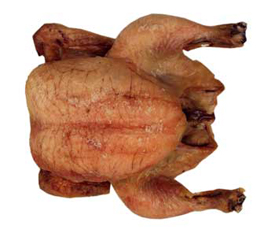
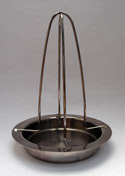 Next up is a vertical wire roasting rack, such as this stainless steel version with an integrated grease pan. The bird slides easily onto the rack when raw, and easily off after cooking.
Next up is a vertical wire roasting rack, such as this stainless steel version with an integrated grease pan. The bird slides easily onto the rack when raw, and easily off after cooking.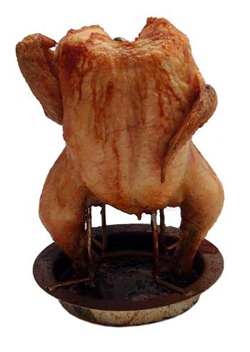
 Finally, on to the beer can experiment. We inserted either an 18 or 24 oz can (depending on the size of the bird), which penetrated about halfway up the chest cavity. We drank 1/4 of the can2, punched a few extra holes in the top for good luck, let it reach room temperature, and then filled the can with 5 crushed garlic cloves to discover if any of the beer or garlic flavor permeates the meat. We also weighed the can to cross-check how much, if any, of the liquid turned to steam. Because the top of the can is beveled, any juices that flowed down the side of the bird did not enter the can.
Finally, on to the beer can experiment. We inserted either an 18 or 24 oz can (depending on the size of the bird), which penetrated about halfway up the chest cavity. We drank 1/4 of the can2, punched a few extra holes in the top for good luck, let it reach room temperature, and then filled the can with 5 crushed garlic cloves to discover if any of the beer or garlic flavor permeates the meat. We also weighed the can to cross-check how much, if any, of the liquid turned to steam. Because the top of the can is beveled, any juices that flowed down the side of the bird did not enter the can.